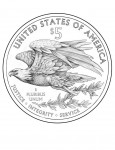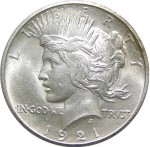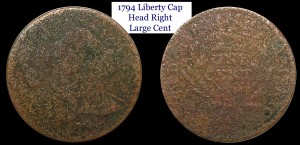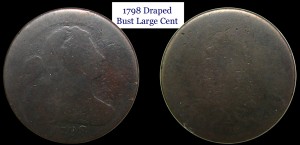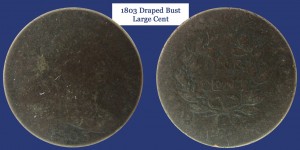Weekly World Numismatic News for January 10, 2021
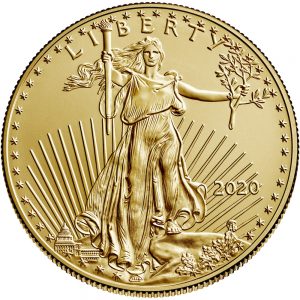 The Weekly World Numismatic News return finds that although 2020 was a stressful year and 2021 has not started with a promise for improvement, the rare coin and paper money market appears healthy.
The Weekly World Numismatic News return finds that although 2020 was a stressful year and 2021 has not started with a promise for improvement, the rare coin and paper money market appears healthy.
Based on a survey of auction houses conducted by the Professional Numismatists Guild, they reported the total sales at auction to be over $419 million. With COVID-19 causing the cancellation of every major show, the auction moved online with success.
A consistent comment is that the auctions provided a means for collectors to liquidate all or parts of their collections to raise money during the pandemic. But for this type of sale to be effective, there have to be bidders to buy the coins. The buyers came.
HiBid, an online auction platform that supports many auction houses, has consistently reported weekly sales on the tens-of-millions of dollars. This year, HiBid reports that traffic to coins.hibid.com was their fastest growing platform.
Finally, with the stock markets soaring with the economic uncertainty growing because of the COVID-19 pandemic, the U.S. Mint saw the sale of American Eagle gold and silver coins increase dramatically. In 2020, the U.S. Mint sold 884,000 ounces of American Gold Eagle coins, increasing 455% from the 152,000 ounces sold in 2019.
The sale of American Silver Eagle coins doubled from last year by selling 30.01 million ounces of silver.
Since the U.S. Mint reports bullion coins more regularly than collector coin sales, those coins’ impact is not reflected in these numbers.
There are collectors out there. Unfortunately, they are not members of the American Numismatic Association or other numismatic organizations. Maybe the numismatic community should use this as a lesson to try to grow the hobby.
And now the news…
 → Read more at thefirstnews.com
→ Read more at thefirstnews.com
 → Read more at people.com
→ Read more at people.com
 → Read more at kitco.com
→ Read more at kitco.com
 → Read more at pilotonline.com
→ Read more at pilotonline.com
 → Read more at thearmchairtrader.com
→ Read more at thearmchairtrader.com
High relief special eagle and missed opportunities
Along with the gold coin will be a companion silver coin struck on the one-ounce planchet that is used for the American Silver Eagle. Although it was not specifically addressed, it is assumed that silver coin will be of the same or similar relief of the gold coin.
This afternoon I was able to break away from my daily activities to attend the CCAC meeting via conference call. This is the first time I attended one of their meetings and came away a little surprised and a little appalled.
What surprised me with the meeting is how in lock-step the committee is on everything. There appears to be no disagreement or questioning of what the U.S. Mint had proposed. Granted the committee members may have history with the issues beyond this meeting, but I was surprised that alternatives were not recommended or discussed.
The committee was excited because the proposal was somewhat in alignment with a motion they passed last April to create a Liberty Medal series. According to Gary Marks, chairman of the CCAC, the Liberty Medal Series would be an arts medal produced by the U.S. Mint to foster new design and innovation. It is to encourage the artists to have artistic impression beyond what they are allowed to do as part of the coin programs.
I do not know if it was previously discussed but according to the authorizing law for the American Silver Eagle bullion program (31 U.S.C. § 5112(e)(3)) the coins must have a design “symbolic of Liberty on the obverse side” and “of an eagle on the reverse side.” The law does not say that the obverse must be Adolph Weinman’s Walking Liberty design and it does not say that the reverse must be a heraldic eagle. Why has the committee not considered using the existing American Silver Eagle program to create a Liberty design program?
In discussing the overall medallic arts program, the CCAC decided to create a study group to come up with a plan to recommend to the U.S. Mint. Aside from the “American Liberty Silver Medal Program,” as described by Marks, he also proposed Freestyle Medal of an American theme. This would be one medal per year that would be artistic representations.
CCAC Member Heidi Wastweet said that the arts medal will allow for experimenting; allow the artist and designers to “expanding our wings” for future projects. As a result, it will let future stakeholders know what is possible so that it would inspire better designs.
While a medals program is a good idea, what seems to be missing is the subject matter. If the Liberty design can be leverage through the American Eagle bullion program, why not have medals used to honor history? Why is it when nations around the world issued commemorative coins honoring D-Day, the United States, whose mint is overly regulated by intransigent politicians, did not issue any commemorative item on the 70th anniversary of an event that changed world history?
Expanding the medals program in this manner would be the perfect way to honor history when congress has failed to remember they represent a country rather their owners… I mean donors!
Where I was appalled was what I saw as over-the-top cult-like patriotic gushing by some of the members over the proceedings. I thought the CCAC was supposed to be an oversight organization; at least that is how it appears to be described in the authorizing law (31 U.S. Code § 5135). There should not be a problem with supporting the work of the U.S. Mint and support the artists whom everyone agrees should be treated better. However, there were some comments that sounded more like members were wrapping themselves in the flag rather than working on an oversight committee.
As part of his closing remarks, Chairman Marks said, “I believe that this is the single most impactful idea that the Mint can pursue at this point in time in the United States.” Unfortunately, I wish this was the case. It appears to be another missed opportunity by the CCAC similar to previous missed opportunities by this committee.
I will have more commentary in the coming days.
Background from the U.S. Mint
2015 Silver Medal
- As a result of the success and popularity of the 2009 Ultra High Relief Double Eagle Gold Coin, the United States Mint (Mint) is considering producing a 2015 24-karat Gold Ultra High Relief (UHR) Coin.
- The CCAC recommended a new eagle design for the reverse of the American Eagle Silver One Ounce Coin, a change the Mint is not pursuing, opting instead to consider showcasing the beauty and intricacies of the recommended design on a 2015 24k Gold UHR Coin.
- To compliment such a reverse, the Mint would consider featuring a new, modern rendition of Liberty on the obverse of the 2015 24k Gold UHR Coin.
- If developed, a 2015 24k Gold UHR Coin would be comparable to the 2009 Ultra High Relief Double Eagle Gold Coin, in that it would also be one troy ounce. The denomination would also have to be determined.
- To make such a design accessible to various ranges of collectors, the Mint is considering the possibility of producing a medal, struck in silver, bearing the same design as a 2015 24k Gold UHR Coin. Striking these medals in silver would provide an additional opportunity to showcase the intricacy of the design features and the beauty of the artwork.
- If this concept is pursued, the United States Mint would seek Secretary of the Treasury approval to strike this gold coin under authority of 31 U.S.C. § 5112(i)(4)(C).
- If this concept is pursued, the United States Mint would seek Secretary of the Treasury approval to strike this silver medal under authority of 31 U.S.C. § 5111 (a)(2).
- In 2009, the United States Mint fulfilled the original vision of Augustus Saint-Gaudens with the release of the 2009 Ultra High Relief Double Eagle Gold Coin; closing one chapter of American coin design and beginning a new one.
- If produced, 2015 24k Gold UHR Coins could be viewed as a follow up to the 2009 Double Eagle UHR, contrasting classic American coin design with modern American coin design.
High relief speculation
In 2008, it became then Mint Director Edmund Moy’s “pet project” to create the ultra-high relief Augustus Saint-Gaudens double eagle design in a manner that Saint-Gaudens originally envisioned. The result was the 2009 Ultra High Relief Gold Coin. The design was based on the plaster casts originally made by Saint-Gaudens that was digitized and the equipment purchased that would be able to strike the coin.
Moy is no longer Director but the U.S. Mint still has the equipment used to strike the coin. The question is what does the U.S. Mint have in mind for creating a high-relief coin?
Also, what do they have in mind for an accompanying silver medal and how do they justify creating a medal? While the U.S. Mint can use the same law that authorizes the 24-Karat Gold Buffalo coin (31 U.S.C. § 5112(q)), it is uncertain what can be leverage for the silver medal. It is possible that the U.S. Mint might be leveraging 31 U.S.C. § 5111(a)(2) that says The Secretary of the Treasury “may prepare national medal dies and strike national and other medals if it does not interfere with regular minting operations but may not prepare private medal dies.” Before we pass further judgement we will wait to hear what the U.S. Mint says.
As for the subject, since they Saint-Gaudens double eagle design as been used, what other high-relief design has issues? The only design that comes to mind is the Anthony de Francisci Peace dollar. But not just the Peace dollar, but the original design with the broken sword.
The broken sword was not well received. According to numismatic researcher Roger Burdette, he discovered a editorial that appeared in the New York Herald that summarized the feeling about the broken sword:
Aside from being too high of a relief for efficient striking, U.S. Mint Chief Engraver George Morgan modified the models using fine engraving tools under extreme magnification at the last moment to remove the broken sword. De Francisci was asked to be in Philadelphia as Morgan made the modifications to ensure the work met with his approval. As part of the modification, Morgan extended the olive branch and removed some of its parts to make it look as if it was de Francisci’s original work. Morgan also sharpened some of the details, strengthened the sun’s rays and straightened the eagle’s leg to give it a better appearance. The work was done so well that nobody realized that Morgan made these changes until Burdette uncovered the details in his research.A sword is broken when its owner has disgraced himself. It is broken when a battle is lost and breaking is the alternative to surrendering. A sword is broken when the man who wears it can no longer render allegiance to his sovereign. But America has not broken its sword. It has not been cashiered or beaten; it has not lost allegiance to itself. The blade is bright and keen and wholly dependable. It is regrettable that the artist should have made such an error in symbolism. The sword is emblematic of Justice as well as of Strength. Let not the world be deceived by this new dollar. The American effort to limit armament and to prevent war or at least reduce its horror does not mean that our sword is broken.
Although struck in Denver in late December 1921, the 1921-D Peace dollar was released into circulation on January 3, 1922.
Later that year it was determined that the high-relief design was causing dies to break at a faster pace than planned. The Mint then lowered the relief in order to keep striking coins at the rate required by law. This became the second type of the Peace dollar series.
Because 2015 will be 95 years since the first Peace dollar, I suspect that the high-relief gold coin will be a 2015 tribute to that first Peace dollar.
As for a companion silver, there is an interesting story about an attempt to produce the Peace dollar in 1964. In 1964 the price of silver rose to new heights that it made the value of ordinary circulating coins worth more for their metals than their face value. Because of this, silver coins were being hoarded by the public and becoming scarce in circulation. Western states that relied on hard currency including the gaming areas of Nevada needed the U.S. Mint to strike additional coins for circulation.The striking of a dollar coin had a powerful ally: Senator Majority Leader Mike Mansfield, Democrat from Montana, whose state would be directly affected by the new coins. Although the numismatic press was not in favor of the measure because of its limited ability to solve the coin shortage, Mansfield pushed a bill through congress to authorize the Mint to strike 45 million silver dollars.
After much discussion, the Mint looked for working dies but found that few survived a 1937 destruction order. Those that did survive were in poor condition. Mint Assistant Engraver Frank Gasparro, who would later become the Mint’s 10th Chief Engraver, was authorized to create new dies of the Peace dollar with the “D” mintmark. Since the coins would mostly circulate in the west it was logical to strike them closest to the area of interest.
When the coins were announced, coin dealers immediately offered $7.50 per coin which would ensure that they would not circulate as intended. Everyone saw this as a poor use of Mint resources during a time of severe coin shortages. Adams announced that the pieces were trial strikes never intended for circulation and were later melted under reportedly heavy security.
There have been reports that some Peace dollars were struck using base metals (copper-nickel clad) as experimental pieces in 1970 in anticipation of the approval of the Eisenhower dollar. The same reports also presume these coins have been destroyed.
While we are speculating, the companion silver medal could be a modern tribute to the 1964-D Peace dollar by minting a 1915-D silver medal with the same design but without a denomination. It would be the same design but with out “ONE DOLLAR” struck on the reverse.
A high-relief 24-karat gold Peace dollar design and a silver version without the denomination. That’s my prediction, what’s yours?
1921-D Peace dollar courtesy of the author.
Artists conception of the 1964-D Peace dollar courtesy of PCGS.
Are you having fun?
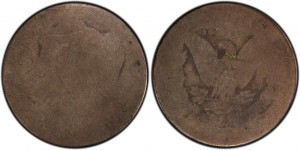
This 1878 eight tail feathers Morgan dollar, graded PCGS PO-1 (none worse!), is from the End of the Trail VIII Collection of Low Ball Morgan dollars that will be exhibited for the first time during the 2014 ANA World’s Fair of Money.
In 2009, PCGS began to offer rewards for what they called and “everyman” or second tier registry competition. Apparently, it became a race to the bottom. While people are looking for the best coins their money can buy, someone went quite the opposite and set out to find the worst of the worst.
“It is the all-time finest, or in this case, the worst-of-the-worst basic Morgan dollar set in the Low Ball category. While collectors have a lot of fun with the Low Ball sets, remember that it often is just as difficult and exciting to build a low grade set as it is to assemble a high grade collection,” said PCGS President Don Willis.
Who am I to argue. After all, someone put together a set of PO-1 and FR-2 coins, many marked “None Worse,” and probably cost more to have them graded than the coins cost to purchase. Then who is to say that some did not find their way into a pocket or two before being submitted?
Cynicism aside, there is something ironic about putting together a set like this and it has to do with just having fun. It had to be a lot of fun to go around and search through junk boxes or ask dealers for their worst coins. It must have been interesting seeing the face of some of the dealers when they hand over their worst Morgan dollars only to be told they were not bad enough.
Think about it for a moment. Dealers are looking for the best, most pristine inventory to sell to eager buyers who walk by their cases looking at the pretty and shiny coins. When coins are not good enough to make the inventory, they are thrown into junk boxes for people to pick through. Larger coins, like Morgan dollars, would be sold for a price around their melt value since there would not be much of a numismatic premium.
The adventure had to be a lot of fun for the person assembling the set.
That what this is all about, having fun! If you are stressing out about the worth of your set, are you really having fun? Are you having fun worrying about the plastic entombing the coin or whether someone placed a sticker on that plastic or is the coin the most important part of your collection?
I know the registry sets exist for the third-party grading services to promote their products and get people to submit coins. I know putting together a top set can be gratifying. But is it fun? Are you putting together that set for the fun or the profit?
There are a lot of people who collect coins in some form. Some collect high grade Morgan dollars while others collect varieties or VAMs. Some pursue the best and most rare coins while you find many digging through junk boxes at the shows looking for that one small gem to fill the hole in their collection. You may like high-grade Buffalo nickels while others are searching half-dollar rolls they pick up at their local bank.
Regardless of how you collect, what you collect, and where you find your collection, if you are not having fun then maybe you should rethink what you are doing.
Just for kicks, here are three of my “low ball” coins:
Now if you would excuse me, there are some tokens and medals from my hometown of New York I bought at the Whitman show I need to add to my collection.
An ancient dilemma
During a time where disinformation is a product of hyper-partisanship, it is difficult to write about issues without feeding into the conspiracy theories of the day. The problem with conspiracy theories is that there are so many moving parts and so many people who would have to cooperate that when you really think about their content beyond the headline, you understand how difficult it would be for conspiracies to exist on the scale many suggest.
Conspiracy theories are not a new phenomenon. What is new is how fast they can spread and how the extremes on both side of the aisle can see the same circumstances are come up with radically different conclusions.
Rather than talk about conspiracies, we should look at the issues as more of the result of unintended consequences.

1933 Saint Gaudens Double Eagle is an example of the Law of Unintended Consequences.
For collectors of ancient coins, it is difficult to ignore the law of unintended consequences of Cultural Property Implementation Act (CPIA; 19 U.S.C. §§ 2601 et seq.) and how it is implementation by the State Department’’s Cultural Property Advisory Committee (CPAC). CPIA is the law that was created when the United States signed and the Senate approved the Convention on the Means of Prohibiting and Preventing the Illicit Import, Export and Transfer of Ownership of Cultural Property 1970, often called the 1970 UNESCO Convention. The purpose of the treaty was to stop archaeological pillaging and trafficking in cultural property. In real terms, it would prevent the filling of the British Museum in London with the artifacts from ancient Egypt, Greece, the Middle East, North Africa, and any other place where the British tried to maintain their empire.

EID·MAR Silver Coin commemorating the death of Cæsar on March 15
Although this may sound reasonable, Article 1 paragraph (e) of the treaty defines a category of cultural property as “antiquities more than one hundred years old, such as inscriptions, coins and engraved seals.” This means that any coin minted before 1914 can be considered cultural property and not only be subject to restrictions but confiscated if it cannot be proven that it was found or purchased legally prior to the convention.
With the different rules and laws around the world that has different documentation requirements that were more lax prior to the convention, how does the collector of ancient coins prove the coin that was bought in good faith from a dealer or another collector is not a country’s cultural property? A coin that could have changed hands hundreds of times since it arrived in the United States and enjoyed by its collectors may have had its more modern provenance lost to time and be subject to confiscation by the State Department and returned to the country of origin.
Although the CPAC tries to make the Memoranda of Understanding between the foreign country and the United States simple, the law and convention has a number of problems that have not been addressed in the 40 years it has been in existence. One problem is the existence of ancient Roman coins all over Europe. While the coins were minted in Rome, they were carried throughout the empire by the military, business people, and travelers that were eventually left behind. Since the coins were struck in Rome does it mean that the coins are the property of Italy or the country where they were found? If they country where they were found follows the convention to its letter, since the coins were not manufactured there are they really cultural objects and subject to these export and trade restrictions?
While those of us in the United States have been captivated by the Saddle Ridge Hoard of gold coins, people in the United Kingdom have been buying metal detectors in record number to scour the countryside looking for ancient coins left behind by their ancestors. Recently, someone found four coins dating back to the Iron Age that sparked an archeological search. The find included Roman coins that were not made in England or the land that would become England. Are these British artifacts?
As an aside, British law allows the finders to keep the coins. But since the full archeological search was managed by a British university in conjunction with the military, subsequent finds are the property of the crown since both are paid using public tax money. However, based on the wording of the 1970 UNESCO Convention, does Italy have a claim if they want to pursue those coins?
 Recently, the CPAC held an open meeting to hear the new Egyptian government’s request to ban the import of artifacts dating through the time of the Ottoman Empire. Based on reporting by Richard Gierdroyc in Numismatic News, the questioning of the committee and the answers by those representing the archeological community not only would not grant an exemption for coins but would consider the confiscation of coins that could not be proven to have been legally purchased prior to the 1970 UNESCO Convention and have since fairly traded.
Recently, the CPAC held an open meeting to hear the new Egyptian government’s request to ban the import of artifacts dating through the time of the Ottoman Empire. Based on reporting by Richard Gierdroyc in Numismatic News, the questioning of the committee and the answers by those representing the archeological community not only would not grant an exemption for coins but would consider the confiscation of coins that could not be proven to have been legally purchased prior to the 1970 UNESCO Convention and have since fairly traded.
There is a very vocal crowd in the archeological community that would want to see everything dug up from the earth put into museums or otherwise locked away from the public. (Links to these people omitted on purpose) Using the pejorative “coinys” to describe collectors of ancient coins, these people have advocated for the confiscation of these coin so that they can be entombed behind display glass inside the state run museums of the world. They consider coinys profiteers who would rather trade in history than preserve history.
Collecting, in all of its forms, is a preservation of history. Whether you collect coins, stamps, political campaign buttons, old car emblems, license plates, old kitchen objects, books, toys, postcards, letters, and other ephemera, these items would be lost to time if people did not save them. Owning history helps connect us to our past and even helps us understand how the world has evolved.
History must be preserved and every country has the right to protect the property within its borders. If Egypt wants to protect its property and any future property that archeologists discover, then that should be their right. However, if Egypt wants to restrict United States collectors of coins or other artifacts that have been in circulation for many years, it is suggested that they end their hypocrisy by preying on the “we must do right by the world” policies of the United States and demand that the British Museum to return its holdings.
June Legislative Update
 At the beginning of each month, I like to provide my readers with a progress with coin or coin industry-related legislation being considered in congress. For the third time this session, there were no new coin-related bills introduced and those that have been submitted have not seen any legislative action. Considering congress has begun their summer break, there will probably be nothing to report for this month.
At the beginning of each month, I like to provide my readers with a progress with coin or coin industry-related legislation being considered in congress. For the third time this session, there were no new coin-related bills introduced and those that have been submitted have not seen any legislative action. Considering congress has begun their summer break, there will probably be nothing to report for this month.
In similar news, on September 12, 2014, Richard A. Peterson, Deputy Director of the United States Mint provided a status to the House Financial Services Committee about the Alternative Metals Study. The only news to come out of the hearing was the recommendation by Rep. Steve Stivers (R-OH) to use steel as a coinage metal. Stivers was reported to have said, “Steel costs about $900 a ton versus some of the other metals that cost up to $5,000 a ton or $12,000 a ton.”
Prior to the hearing, the U.S. Mint extended the deadline for public comment on the Alternative Metals Study. Predictably, representatives for the vending and coin-operated machine industries called on the U.S. Mint and the congress to maintain the status quo.
Outside of Washington, there is an issue with the enforcement of a consumer protection law in Minnesota that requires dealers with more than $5,000 in sales of bullion coins to register in Minnesota. One of the problems with the definition is that the Minnesota law defines “Bullion Coin” as “any coin containing more than one percent by weight of silver, gold, platinum, or other precious metal.” (see Minnesota Stat. §80G.01 Subd. 2). This means that dealers selling more than $5,000 of Mercury dimes or Barber quarters are required to register the same way as those selling American Eagle coins.
To learn more about this issue, I recommend a reading “Dealers to reject Minnesota clients” by Pat Heller that was published in Numismatic News. There will be more on this and similar laws in other states in future posts.
In keeping with the legislative theme, the following is what has been considered by the 113th congress thus far:
Bills Signed into Law
The following has passed both the House of Representatives and Senate and has been signed by the President of the United States into law:
- Public Law 113-10 (formerly H.R. 1071: To specify the size of the precious-metal blanks that will be used in the production of the National Baseball Hall of Fame commemorative coins.
Bills Passed in the House of Representatives
The following bill passed the House and is awaiting action in the Senate:
- H.R. 2754: Collectible Coin Protection Act
Introduced in the House of Representatives
- H.R. 77: Free Competition in Currency Act of 2013
- H.R. 220: Stop the Coin Act
- H.R. 627: National Park Service 100th Anniversary Commemorative Coin Act
- H.R. 1218: Commemorative Coins Reform Act of 2013
- H.R. 1653: Pro Football Hall of Fame Commemorative Coin Act
- H.R. 1719: Cents and Sensibility Act
- H.R. 1905: Mother’s Day Centennial Commemorative Coin Act
- H.R. 2366: World War I American Veterans Centennial Commemorative Coin Act
- H.R. 2633: Thirteenth Amendment Commemorative Coin Act
- H.R. 2760: Panama Canal and Pan-Pacific Exhibition Centennial Celebration Act
- H.R. 2932: United States Coast Guard Commemorative Coin Act
- H.R. 3146: Savings, Accountability, Value, and Efficiency (SAVE) II Act
- H.R. 3305: Currency Optimization, Innovation, and National Savings Act
- H.R. 3680: Breast Cancer Awareness Commemorative Coin Act
- H.R. 3729: Korean Immigration Commemorative Coin Act
Introduced in the Senate
Even though financial bills are constitutionally required to begin in the House of Representatives, it is not beneath the Senate to introduce their own legislation or concurrent bills with the House. Coin-related bills introduced in the Senate are usually referred to the Senate Committee on Banking, Housing, and Urban Affairs. The bills introduced in the Senate are as follows:
- S. 94: To terminate the $1 presidential coin program
- S.203: Pro Football Hall of Fame Commemorative Coin Act
- S. 768: Sound Money Promotion Act
- S. 1011: Boys Town Centennial Commemorative Coin Act
- S. 1105: Currency Optimization, Innovation, and National Savings Act
- S. 1158: National Park Service 100th Anniversary Commemorative Coin Act
- S. 1842: Pro Football Hall of Fame Commemorative Coin Act
- S. 2303: United States Coast Guard Commemorative Coin Act
- S. 2310: Mother’s Day Commemorative Coin Act

